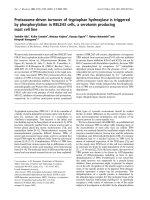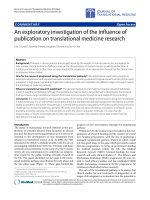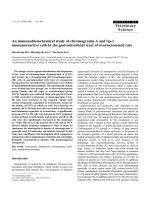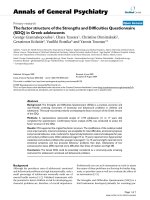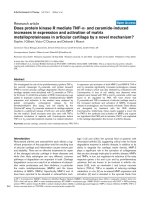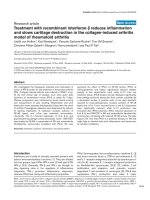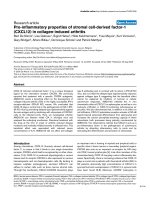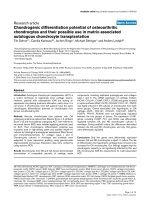Báo cáo y học: " An exploratory survey of money boys and HIV transmission risk in Jilin Province, PR China" potx
Bạn đang xem bản rút gọn của tài liệu. Xem và tải ngay bản đầy đủ của tài liệu tại đây (441.78 KB, 8 trang )
Meng et al. AIDS Research and Therapy 2010, 7:17
/>Open Access
SHORT REPORT
© 2010 Meng et al; licensee BioMed Central Ltd. This is an Open Access article distributed under the terms of the Creative Commons
Attribution License ( which permits unrestricted use, distribution, and reproduction in
any medium, provided the original work is properly cited.
Short report
An exploratory survey of money boys and HIV
transmission risk in Jilin Province, PR China
Xiangdong Meng
1
, Allen F Anderson*
2
, Lu Wang
3
, Zhihe Li
1
, Wei Guo
1
, Zixuan Lee
1
, Huixin Jin
4
and Yong Cai
5
Abstract
This report represents the first exploratory study of Chinese men who provide commercial sex services to other men
("money boys") in Jilin Province, People's Republic of China, through a convenience sample drawn from Changchun
and Jilin City. A total of 86 active money boy participants (Changchun, n = 49; Jilin City, n = 37) were surveyed
concerning background and demographics, basic HIV transmission knowledge, and sexual practices. The survey
indicated that while Jilin Province money boy behavior matches other studies concerning propensity to high risk
behavior and significant bridging potential, the Jilin money boys, unlike previous studies, exhibited a high level of basic
HIV/AIDS transmission knowledge. In spite of this level of knowledge, none of the participants reported always using a
condom in their sexual activities. They also exhibited a high level of awareness of voluntary counseling and testing
available in the province, yet relatively few had availed themselves of these services. These preliminary findings will be
used as a baseline and springboard for continuing study in the Jilin Province money boy community. Even now,
however, it is becoming clear that the dynamics of male commercial sex work may vary greatly depending upon local
influences, and will necessitate that future interventions are highly tailored to area-specific circumstances.
Introduction
The dire progression of the Human Immunodeficiency
Virus (HIV) in China was highlighted in early 2009, when
reports emerged that it was the leading cause of infec-
tious disease mortality during the previous year [1].
While the national prevalence is estimated to be only
0.1% [2], the epidemic is driven by high-risk behaviors
within particular sub-populations that create pockets of
high infection. These pockets often serve, in turn, as con-
duits for the disease into the broader heterosexual popu-
lation through complex behavioral dynamics (i.e.,
bridging activities related to sex work and drug use, etc.)
that are yet to be fully investigated [3-6].
One such area of high prevalence is among men who
have sex with men (MSM). While much effort was placed
early-on into understanding the nuances of HIV trans-
mission in the drug injector and female sex work popula-
tions, general recognition of the depth and breadth of the
MSM population was not acknowledged. It was only after
2003 that the MSM population began to receive broad
scrutiny on the mainland; indeed, it was not until 2002
that the MSM population was included in the national
HIV sentinel surveillance [7,8]. UNAIDS now reports
that the HIV prevalence within the Chinese MSM popu-
lation is within a range from 2.5-6.5 percent [9].
Under Confucianism, the traditional family unit is
patriarchic, with a dedication to the family line and filial
piety. Confucius viewed the husband-wife relationship as
one of the five primary human relationships that shape
society [10]. Such cultural forces have necessitated that
homosexual conduct be highly cloistered. Fear of ostra-
cism has even driven many homosexuals to marry in an
attempt to conform socially and satisfy family pressures
and expectations [11,12].
No subgroup within this population is more secluded
than the so-called "money boys" (MBs), or males who
provide commercial sex services to other males. In addi-
tion to the socio-cultural dynamics mentioned above,
male commercial sex work is now prosecuted under the
crime of prostitution, which was formerly viewed in the
law as an exclusively female offense [13,14]. The resulting
need for covertness has prevented systematic study of the
MB phenomenon until relatively recently.
Early research suggests that the risk taking in the
broader MSM community is magnified among money
boys. Generally, the research indicates that MBs "rarely
insist on condom use, and may engage in unprotected
* Correspondence:
2
Indiana University South Bend, South Bend, Indiana, USA
Full list of author information is available at the end of the article
Meng et al. AIDS Research and Therapy 2010, 7:17
/>Page 2 of 8
anal sex because they are following the wishes of their cli-
ents [12,15-17]." Only one study, to date, has found that
rural money boys may increase condom usage after
migrating to large cities [17]. The very nature of the MB
trade would imply that they seek multiple sexual part-
ners, and may yield to client wishes not to use safer sex
practices. Researchers have also found that money boys
generally have "substantial misconceptions regarding
HIV transmission, prevention, diagnosis, and treatment
[18]." Non-transmission modes seem particularly prob-
lematic, with many believing that the virus could be
acquired through mosquito bites, shaking hands, or eat-
ing with an infected individual. In addition to significant
misunderstanding about HIV transmission, it is becom-
ing apparent that many MBs are not aware of the volun-
tary counseling and testing (VCT) services that are now
available in many parts of China [3,18,19]. The picture
that is emerging of MB behavior includes high risk taking,
multiple intimate partners, minimal understanding of
virus transmission, the potential for bridging, and a mix
awareness and use of VCT. It is clear that the intuitive
dangers from MB activity that have been speculated upon
now have growing empirical support.
The present report discusses the first exploratory
research excursion into the money boy phenomenon in
Jilin Province in northeastern China. The tantalizing
seminal findings that emerged from this first look are
preliminary, and will serve as a baseline and springboard
for future analysis.
Methods
After institutional ethical approval was obtained, partici-
pants (N = 86) for the present investigation were
recruited to form a convenience sample from the
Changchun (n = 49) and Jilin City (n = 37) areas, the two
largest cities in Jilin Province. Changchun has an approxi-
mate population of 4 million within the city limits, and
Jilin City's population is around 1.9 million. By Chinese
standards, these are not exceptionally large population
centers. As such, they offer a different setting from previ-
ous MB studies [3,6,12,18,19], with were conducted in
very large and/or highly westernized metropolitan cen-
ters.
A money boy was defined as any male who had pro-
vided sex services (receptive and/or penetrative) to other
males for a fee within the previous six months. Given the
extremely covert nature of such activity in Jilin Province,
initial access into the population was gained through a
relationship being established between the research team
and MSM non-governmental organizations (NGO) in
each city. Actual participant contact was accomplished
through a total of six facilitators who were MSMs associ-
ated with the respective non-governmental organiza-
tions. The use of NGOs to facilitate contact with money
boys has been employed in several recent studies
[15,18,19]. This approach is a variant of Community
Identification Process sampling [20], used to identify hard
to reach populations, and was employed by Choi, et al.
[21] in their Beijing MSM study. Facilitators were trained
to make appropriate contact with MBs and seek their vol-
untary participation in the survey. Four facilitators were
utilized in Changchun, and two in Jilin City. Each of these
individuals facilitated successful contact with 12-16
money boys.
Once agreement to participate had been achieved by
the six facilitators, two trained professionals from the
research team made contact with the individuals and,
after informed consent, administered a limited and struc-
tured face-to-face interview with each MB. After arrange-
ment by the contact facilitator, no money boy refused to
be interviewed by representatives of the research team.
Interviews were conducted in October-November, 2008,
and took place privately in bath houses and gay activity
clubs. On average, interviews lasted 15 minutes. Intervie-
wees received no financial incentive for their participa-
tion. The interview contained queries on background and
demographics, basic HIV transmission knowledge, and
sexual practices, with the previous six months as the time
reference for behaviors. Questions were limited and basic
so as not to make the interviewees uncomfortable or reti-
cent at this early juncture of our work with them.
Results
Demographics
The 86 participants (Table 1) ranged in age from 17 to 38,
with a mean age of 24.6 (SD = 3.22). Sixty-eight (79.1%)
were between 20 and 30 years of age. While the majority
(74.4%) was single, nearly one quarter (24.4%) were mar-
ried. One additional participant (1.2%) reported being
divorced.
Thirty-three (38.4%) of the MBs had a middle school or
less education, while 53 (61.6%) had graduated from high
school or college. Seventy-eight (90.7%) were employed
elsewhere either full-time or part-time. Only 6 (7.0%) of
the participants reported being unemployed. Slightly
over one quarter (27.9%) made less than 1000 RMB
(approximately $143.00US) per month at their place of
employment; yet, 62 (72.1%) made greater than 1000
RMB per month, and 19 (22.1%) made over 2000 RMB
(approximately $286/00US) per month.
The majority of participating MBs (79.1%) were regis-
tered residents of Jilin Province. This comparatively small
number of individuals from other provinces may be a
product of, inter alia, the relative level of employment
opportunities for migrants in the province, as well as the
bitter cold winter conditions. Even when broken into
urban and rural categories, those registered in either
Meng et al. AIDS Research and Therapy 2010, 7:17
/>Page 3 of 8
Changchun or Jilin City (n = 56) outnumbered those reg-
istered in rural areas (n = 30).
Sexual Practice
Sixty-eight (79.1%) of the participants self-identified as
homosexual, while 18 (20.9%) reported a bisexual orien-
tation (Table 2). None of the 86 participants reported
being heterosexual. Sixty-one (70.9%) of the MBs admit-
ted having commercial sex within thirty days of their
respective interview. Anecdotally, the six seeds con-
tended that they had personal knowledge that all partici-
pants had engaged in commercial sexual activity during
the previous month. As hearsay, this had no impact in the
analysis.
While level of commercial sexual activity, reported in
an open-ended format, varied widely, 29 (33.7%) of the
Table 1: Demographics (N = 86)*
Variable Number Percent
Age
<20 44.65
20-30 68 79.07
31-40 14 16.28
Marital Status
Single 64 74.42
Married 21 24.42
Divorced 11.16
Registered Residence
Urban 56 65.10
Rural 30 34.90
Employment (n = 84)
Full-time 38 44.19
Part-time 40 46.51
Unemployed 6 6.68
Education
≤Middle School 33 38.37
High School 39 45.35
College 14 16.28
Monthly Income (yuan)
<1000 24 27.91
1000-2000 43 50.00
2000-3000 12 13.95
>3000 78.14
Present Residence
City 56 65.12
County 22 25.58
Countryside 89.30
*Unless otherwise specified.
Meng et al. AIDS Research and Therapy 2010, 7:17
/>Page 4 of 8
Table 2: Commercial Sexual Behavior (N = 86)*
Variable Number Percent
Self-Identified Sexual
Orientation
Homosexual 68 79.07
Bisexual 18 20.93
Heterosexual 0 00.00
Commercial Sex Activity
Within the Last Thirty Days
Yes 61 70.93
No 25 29.07
CondomUse
Always 000.00
Sporadic 56 65.11
Never 30 34.88
Condom Use During Last
Anal Receptive Experience
Yes 54 62.79
No 36 37.21
Condom Use During Last
Oral Receptive Experience
Yes 23 26.74
No 63 73.26
Natureof Commercial
Sexual Contact
One exclusive client 24 27.90
Only random clients 31 36.05
Both random and exclusive 31 36.05
Locationof Commercial
Sexual Contact (n = 82)
Private House 24 29.26
Public Bath or Hotel 43 52.43
Both Private House or Public 15 18.29
Venue
VCT Service Awareness
Expressed Awareness 68 79.07
Unaware 18 10.93
VCT Service Use
Used 14 20.00
Notused 72 80.00
*Unlessotherwise specified.
Meng et al. AIDS Research and Therapy 2010, 7:17
/>Page 5 of 8
MBs acknowledged greater than 20 total sexual partners.
Below this level of activity, total sexual partners ranged
from 1 to 13, with 4 being the mean number. Twenty-four
(27.9%) reported only one regular commercial sexual
partner, while 31 (36.1%) had both a regular commercial
partner as well as more than one more random (i.e., sin-
gle encounter or highly sporadic encounter) commercial
partner, and 31 (36.1%) had only random commercial
partners. Place of commercial sex activity included pri-
vate houses, bathhouse rooms, and hotel rooms, with
those who had only one regular commercial sexual part-
ner typically meeting in private houses.
None of the 86 MBs reported "always" using a condom
in their sexual activities over the past six months. Only 56
(65.1%) reported using condoms during that time period,
leaving 30 (34.9%) who never used condoms. Fifty-four
(62.8%) had used a condom during their last anal-recep-
tive contact, and 23 (26.7%) during their last oral-recep-
tive contact. There was no difference in condom usage
between those that solicited clients from bars and bath
houses and those who used the internet.
Significantly, 18 (20.9%) had also employed a female
commercial sex worker. This number directly corre-
sponds to the number of participants who self-reported
being bisexual. As well, though probably not mutually
exclusive, the 21 participants who are married are likely
to be maintaining some degree of sexual relationship with
their spouse.
HIV/AIDS Knowledge
The interview instrument included eight questions
related to each participant's level of virus transmission
knowledge (Table 3). If an individual scored six or more
correct answers, his level of understanding was classified
as "good." Seventy (81.4%) MBs scored in this good
understanding category. In spite of this relatively high
level of awareness relative to other MSM/MB studies, 46
(65.7%) of these 70 money boys reported frequent unpro-
tected sexual activity. As well, it must be remembered
that none of the MBs "always" used a condom, yet 79
(91.9%) responded correctly to the specific question on
condom use (Table 3, Question 7). Most participants
reported that they simply did not receive the same physi-
cal and psychological contentment when using a condom.
Continuing their relatively high level of information
about HIV/AIDS, 68 (79.1%) of the sample knew of the
government's voluntary counseling and testing program.
Again, however, this high level of awareness did not
translate into actual utilization. Only 14 of the 70 partici-
pants who exhibited "good" HIV/AIDS knowledge had
used the country's widespread counseling and testing ser-
vices. None of those scoring less than "good" on the trans-
mission knowledge queries had sought VCT services.
Primary rationalizations stated by the participants for
under-utilization were the anticipated mental stress of
being found HIV-positive and the social stigma that the
status carries on the mainland.
Bivariate Analysis
Participants proved quite homogenous concerning
knowledge and behavior whether residing in Changchun
or Jilin City; that is, no statistically significant difference
(requiring P < 0.05) was found between the two locations.
However, significant differences emerged when the group
was analyzed from the urban (n = 56) and rural (n = 30)
perspective. While 49 (87.5%) of the urban registered
MBs scored "good" or better on HIV/AIDS knowledge, 21
(70.0%) of the rural residents scored the same (X
2
= 3.95,
P < 0.05).
Concerning condom use, 41 (73.2%) of the urban resi-
dent MBs had condoms in MSM experiences over the
past six months, whereas 15 (50.0%) of the rural residents
had done the same (X
2
= 4.64, P < 0.05).
Differences between urban and rural MBs continued
concerning type of typical client. Twenty of urban MBs
(35.7%) had one regular client in a private house, while
only 4 (13.33%) of the rural participants had one exclusive
client (X
2
= 4.86, P < 0.05). In contrast, 14 (25.0%) urban
MBs reported having random clients, while 17 rural MBs
(56.7%) reported having random partners (X
2
= 7.74, P <
0.01).
Discussion
The basic demographic and behavioral profile of money
boys in Jilin Province is similar to that found in studies of
other Chinese municipalities [3,12,19]. Most are young,
and highly prone to risk behavior. As elsewhere, a sub-
stantial number of MBs in Jilin Province are married, and
twenty-percent of the MBs also report having used a
female commercial sex worker. It is becoming quite clear
that wherever there is MB activity, there is also going to
be a rather sizable portion who will serve as potential
bridges for HIV to enter the broader heterosexual popu-
lation [4].
However, the present data also make some interesting
departures from previous investigations. Though most of
the Jilin MBs maintained a characteristically high number
of clients, some with over 20 reported sexual liaisons, the
average number of clients for the group was relatively low
at 4. This suggests that, especially in light of regional
behavior variations, male sex work may vary from intense
to only sporadic, yet all such behaviors must be addressed
in an effective intervention strategy. In addition, 27.91
percent of the participants had only one exclusive client,
and engaged in sexual activity in a private house. This
percentage of MBs with exclusive clients may skew the
average number of clients for the group, and account for
the relatively low mean. None of these individuals were
Meng et al. AIDS Research and Therapy 2010, 7:17
/>Page 6 of 8
Table 3: Basic HIV/AIDS Transmission Knowledge (N = 86)
Transmission Knowledge Query Response Percentage
1. Can you identify an HIV-positive Person by his/her appearance
Yes 11 12.79
No 63 73.26
Don'tKnow 12 13.95
2. Can HIV be transmitted through a mosquito bite?
Yes 16 18.60
No 59 68.61
Don't Know 11 12.79
3. Can you contract the virus by eating with an HIV-positive person?
Yes 55.81
No 77 89.53
Don't Know 44.65
4. Can the virus be contracted through a blood transfusion?
Yes 84 97.67
No 0 00.00
Don't Know 22.33
5. Can the virus be contracted through sharing injecting equipment?
Yes 78 90.70
No 33.49
Don't Know 55.81
6. Can an HIV-positive pregnant female transmit the virus to her fetus?
Yes 81 94.18
No 33.49
Don't Know 22.33
7. Does the correct use of a condom reduce the probability of HIV
transmission?
Yes 79 91.86
No 33.49
Don't Know 44.65
8. Can having one exclusive sexual partner reduce the probability of HIV
transmission?
Yes 71 82.56
No 89.30
Don't Know 78.14
Meng et al. AIDS Research and Therapy 2010, 7:17
/>Page 7 of 8
actually "kept" in the home, but only used the residence
as a private venue. Intuitively, one might expect that the
behavioral dynamics of such exclusive encounters, as well
as the most effective health intervention strategy, would
differ for this group. For example, Mi, et al., found that
consistent condom use was associated with having regu-
lar sex partners [4]. Jilin MBs with regular or exclusive cli-
ents require further analysis as to how their behavior
differs, or not, from those with random clients. As well,
more emphasis needs to be placed on variations of behav-
ior based upon sites in which respective MBs tend to
work (i.e., private residences, bath houses, bars, the inter-
net, etc.) [4,15].
Earlier analyses emphasized the propensity of male
migrants to fall into MB activity. When current partici-
pants were divided into urban and rural categories, the
majority were registered urban residents from Changc-
hun or Jilin City. This supports the contention of Zhang
and Chu [7] that HIV transmission dynamics in MSM/
MB communities will vary according to "geographic and
social elements." These preliminary data suggest that
migrants may not necessarily be at the heart of money
boy activity in Jilin Province. This finding is potentially
important, since there is always a danger of increased
social discrimination when one specific subgroup within
a population is singled out as the source of a social prob-
lem. Nevertheless, rural migrants do have lower levels of
HIV transmission knowledge, use condoms less fre-
quently, and have more random commercial clients than
their urban counterparts. As such, this subgroup
demands continued scrutiny.
The concept of "economic necessity," while an impor-
tant concept and highly relevant in areas in which MB
activity is dominated by males from the floating popula-
tion, seemed to have less relevance among the Jilin partic-
ipants. None of the participants self-reported as
heterosexual and engaging in MB activity to subsist. Most
were gainfully employed and received a livable income by
regional standards. While those participants with very
high levels of clients would have been able to better sup-
plement their regular income through MB activity, the
average number of clients reported (4) would not be a
source of substantial income unless there were very high
levels of sexual activity. The average price of either oral or
anal sex services in the province is only 100-200 yuan
(approximately US$14.00-$28.00). However, frequency of
sexual activity was not addressed in these data, nor was
the concept of "underemployment" that might drive some
to commercial sex activity. Finding that behavior is not
driven by subsistence does not necessarily mean that eco-
nomics does not contribute. Much more precision should
be built into future studies in determining to what degree
income motivates behavior.
Most prior studies have also found a poor level of
understanding regarding basic HIV/AIDS knowledge, as
well as a correlation between education and such knowl-
edge [18,19]. Jilin MBs actually scored quite well on basic
transmission knowledge and prevention, as well as
knowledge of voluntary testing and counseling services
now found throughout the country. No association, how-
ever, was discovered between educational level and HIV
knowledge, as has been found previously [19].
Regardless of education, Jilin MBs seemed well aware of
basic HIV transmission principles. Unfortunately, this
knowledge did not translate well into positive behavioral
change. None of the 86 participants reported always
using a condom, and only 14 had used VCT services.
Clearly, "mere" knowledge is not enough for this group.
This finding adds support to a recent and thorough analy-
sis of MBs in Shenzhen, in which it was found that con-
dom use was low, even in the face of high HIV-related
knowledge and knowledge of sero-status [14].
Conclusion
Two primary caveats must be kept in mind when reading
this report of the initial questioning of money boys in Jilin
Province. First, the size of the convenience sample is
small. However, the number of participants represents all
MBs that could be located at this juncture of breaking
into the Jilin Province community. The number of identi-
fied participants was impacted by the exceedingly covert
nature of MB activity in Jilin Province, as well as the reach
of the assisting NGO. Participants, nevertheless, fit nicely
into previously established demographic characteristics
(age, education, etc.) of MBs in other studies. As such,
they may be said to be typical of the broader MB popula-
tion from which they are drawn, though simply repre-
senting a convenience subgroup within it. As such, we do
not contend that the sample is representative of the
broader Jilin money boy population. We do contend that
it provides a good baseline for future analysis, and keeps
us mindful of the fact articulated by Zhang and Chu [7]
that MB behavior may vary greatly, depending upon local
circumstances and practices.
Second, there is the potential for selection bias in the
sample, since all participants were located through con-
tact facilitators associated with local MSM non-govern-
mental organizations. The dominance of urban MBs is
the sample may be an artifact of this selection method.
Perhaps urban MBs are more likely to align themselves
with a local organization than those coming from outside
the urban area. As such, the dominance of urban partici-
pants in the survey, as well as their behavior when con-
trasted to rural participants, must be carefully
reinvestigated in future studies in the province.
This first look at MBs in Jilin Province suggests that
male commercial sex work may not necessarily be driven
Meng et al. AIDS Research and Therapy 2010, 7:17
/>Page 8 of 8
by migrants, though migrants do seem to be more prone
to riskier commercial sex and more random sexual con-
tacts than their urban counterparts. Money boys may
possess a relatively high level of HIV/AIDS transmission
knowledge, yet such knowledge is not reflected in the
adoption of safer sex practices. Economic subsistence
may not always be the primary driving factor in male
commercial sex work. A blanket explanation of money
boy activity, isolated from local circumstances and prac-
tices, is not in the offing.
Clearly, much more investigation needs to be con-
ducted in the province before a more definitive picture of
money boy behavior is obtained. Many questions are sug-
gested in this report that await investigation, especially
related to urban-rural differences in behavior, factors pre-
venting behavioral change in light of good transmission
and control knowledge, the low number of commercial
partners relative to other studies, variability of condom
use between non-commercial and commercial partners,
and possible variations in behavior between MBs in dif-
ferent commercial venues. This exploratory look will
allow us to ask the right questions as our analysis contin-
ues. One thing, however, is becoming clear as we work to
develop a more definitive understanding of male com-
mercial sex work in the province. Such activity can be
ignored only at the peril of substantially reducing the
effectiveness of broader HIV/AIDS prevention and con-
trol efforts in Jilin Province.
Acknowledgements
This research was jointly funded by the Chinese Social
Mobilization Project (2007) and the China-MSD AIDS
Cooperation Project (2008). Funding bodies played no
direct role in the research process.
Competing interests
The authors declare that they have no competing interests.
Authors' contributions
MX participated in the development of the methodology, collected data, ana-
lyzed data, and developed the manuscript. AA participated in the develop-
ment of the methodology, analyzed the data, and developed the manuscript.
LZ participated in the development of the methodology, and collected and
analyzed data. WL, GW, LZ, JH, and CY participated in the development of the
methodology and collected data. All authors read and approved the final man-
uscript.
Author Details
1
Jilin Provincial Center for Disease Prevention and Control, Changchun, China,
2
Indiana University South Bend, South Bend, Indiana, USA,
3
National Center for
STD & AIDS Prevention and Control, Beijing, China,
4
The Institute for
Dermatosis Prevention and Control, Harbin, China and
5
Jilin Municipal Center
for Disease Prevention and Control, Changchun, China
References
1. The Associated Press, International News: AIDS becomes China's
deadliest. 2009 []. Accessed 18 February 2009
2. UNAIDS: China Fact Sheet. 2009 [ />CountryResponses/Countries/China.asp]. Accessed 5 January 2010
3. Choi KH, Gibson D, Han L, Yaqui G: High levels of unprotected sex with
men and women among men who have sex with men: a potential
bridge of HIV transmission in Beijing, China. AIDS education and
Prevention 2004, 16(1):19-30.
4. Mi G, Wu Z, Zhang B, Zhang H: Survey of HIV/AIDS-related high risk
behaviors among male sex workers in two cities in China. AIDS 2007,
21:S67-S72.
5. Guo L, Zhang L, Jin Q: Meta analysis: prevalence of HIV infection and
syphilis among MSM in China. Sexually Transmitted Infections 2009,
85:354-358.
6. Lau JTF, Wang M, Wong HN, Tsiu HY, Kia M, Cheng F, Zhang Y, Su X, Wang
N: Prevalence of bisexual behaviors among men who have sex with
men (MSM) in China and association between condom use in MSM
and heterosexual behaviors. Sexually Transmitted Diseases 2008,
35:406-413.
7. Zhang BC, Chu QS: MSM and HIV/AIDS in the People's Republic of
China. Cell Research 2005, 15:858-864.
8. Hong FC, Zhou H, Cai Y, Pan P, Feng T, Liu X, Chen X: Prevalence of
syphilis and HIV infections among men who have sex with men from
different settings in Shenzhen, China: implications for HIV/STD
surveillance. Sexually Transmitted Infections 2009, 85:42-44.
9. UNAIDS: China to tackle HIV infections amongst MSM. 2009 [http://
unaids.org/en/KnowledgeCentre/Resources/FeatureStories/archive/
2009/20090116_MSMAsia.asp]. Accessed 18 February 2009
10. Chan WT: A Sourcebook in Chinese Philosophy Princeton: Princeton
University Press; 1963.
11. Aegis-Reuters: Sex taboos hamper safety message for gay Chinese.
2006 [ Accessed 13
August 2006
12. Liu HJ, Liu H, Cai Y, Rhodes A, Hong F: Money boys, HIV risks, and the
associations between norms and safer sex: a respondent-driven
sampling study in Shenzhen, China. AIDS and Behavior 2009,
13:652-662.
13. China Daily: 4 members of a male sex ring jailed. 2008 [http://
chinadaily.com]. Accessed 15 January 2009
14. Jeffreys E: Querying queer theory: debating male-male prostitution in
the Chinese media. Critical Asian Studies 2007, 39(1):151-175.
15. Cai WD, Zhao J, Zhao Jk, Fisher R, Feng YJ, Liu J, McFarland W, Gan YX,
Yang ZR, Zhang Y, Tan JG, Wang XR, He ML, Cheng JQ, Chen L: HIV
prevalence and related risk factors among male sex workers in
Shenzhen, China results from a time-location-sampling survey.
Sexually Transmitted Infections 2009 in press. doi:10.1136/sti2009.037440
16. Zhang B, Liu D, Li X, Hu T: A survey of men who have sex with me in
China. American Journal of Public Health 2000, 90(2):1949-1950.
17. Kong TSK: Risk factors affecting condom use among male sex workers
who serve men in China: a qualitative study. Sexually Transmitted
Infections 2008, 84:444-448.
18. He N, Wong FY, Huang JZ, Fu C, Smith BD, Young D, Jiang Q: HIV risk
among two types of male migrants in Shanghai, China, money boys vs.
general male migrants. AIDS 2007, 21(Suppl 8):573-579.
19. Wong FY, Huang Z, He N, Smith BD, Ding Y, Fu C, Young D: HIV risks
among gay and non-gay-identified migrant money boys in Shanghai,
China. AIDS Care 2008, 20(2):170-180.
20. Higgins DL, O'Reilly K, Tashima N, Crain C, Beeker C, Goldbaum G, Elifson
CS, Galavotti C, Guenter-Grey C: Using formative research to lay the
foundation for community level HIV prevention efforts: an example
from the AIDS Community Development Projects. Public Health Reports
1996, 111:28-35.
21. Choi KH, Diehl E, Yaqi G, Qu S, Mandel J: High HIV risk but inadequate
prevention services for men in China who have sex with men: an
ethnographic study. AIDS and Behavior 2002, 6:255-266.
doi: 10.1186/1742-6405-7-17
Cite this article as: Meng et al., An exploratory survey of money boys and
HIV transmission risk in Jilin Province, PR China AIDS Research and Therapy
2010, 7:17
Received: 6 April 2010 Accepted: 17 June 2010
Published: 17 June 2010
This article is available from: 2010 Meng et al; licensee BioMed Central Ltd. This is an Open Access article distributed under the terms of the Creative Commons Attribution License ( ), which permits unrestricted use, distribution, and reproduction in any medium, provided the original work is properly cited.AIDS Research and Therapy 2010, 7:17
